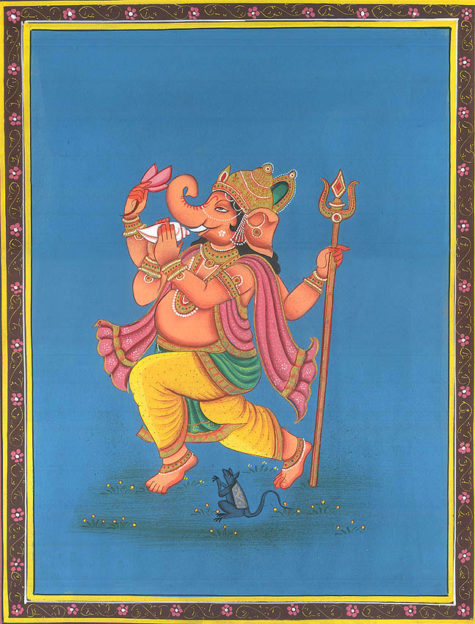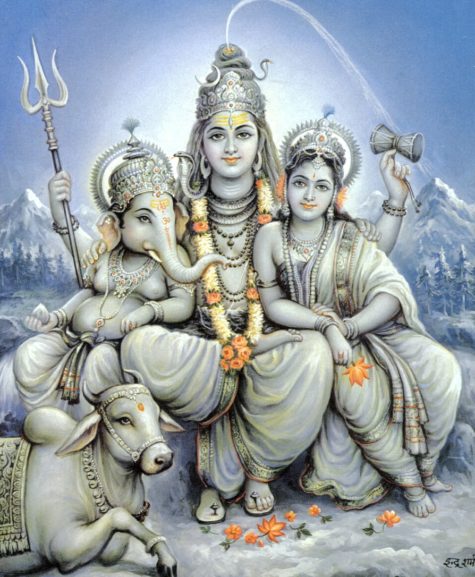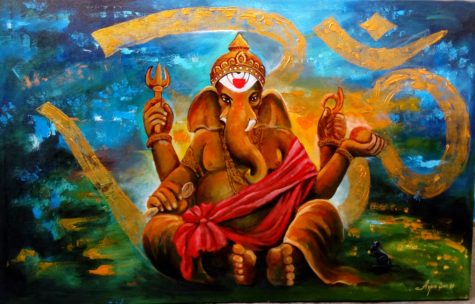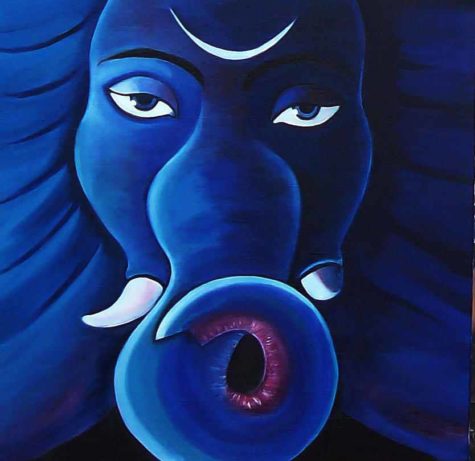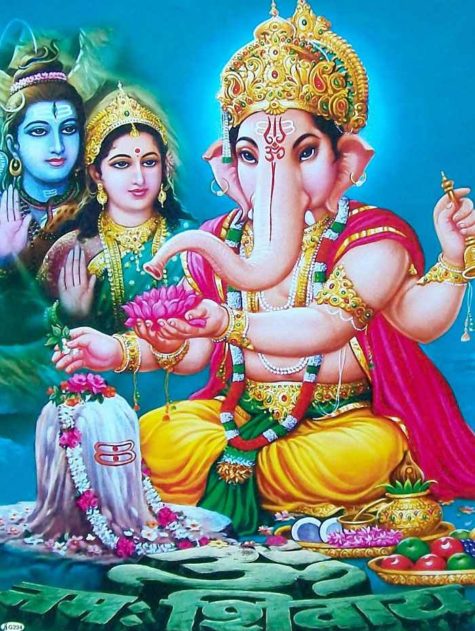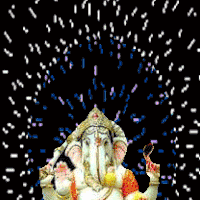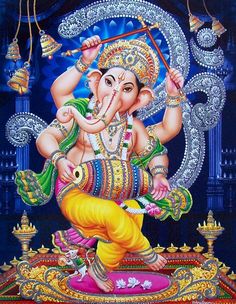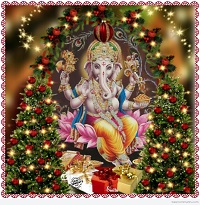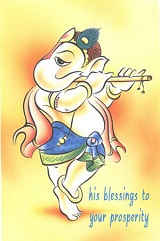Mythology
The Story Of The Missing Conch
This is a wonderful story that showed how even Lord Vishnu had to relent to Lord Ganesha’s antics.
Vishnu was known to have a conch with him that he kept with himself at all times. One fine day, he noticed that the conch was missing and it was nowhere to be found. This got him extremely annoyed and he rallied all his powers into finding the conch.
As the search for the conch was on, Lord Vishnu suddenly began hearing the sound of the conch emanating from a distance. He began searching for it in that direction and soon realized that the sound was coming from Mount Kailash itself. As he reached the mountain, he found out that the conch had been taken by Lord Ganesha and he was busy blowing it. Knowing that Lord Ganesha will not relent easily, he sought out Shiva and asked him to request Ganesha to return the conch back to him.
Shiva said he, too, didn’t have any power of Ganesha’s wishes and the only way to appease him is to perform a puja for him. So Lord Vishnu did do that. He set up all the necessary elements for the puja and worshiped Ganesha with his heart. Seeing this, Ganesha was extremely pleased and he returned Vishnu’s conch back to him.
Moral
The story quite interestingly reveals the fun side to Lord Ganesha and his antics. Furthermore, it teaches us about humility by showing how a God as great as Vishnu, did not hesitate to worship Ganesha.
From: First Cry Parenting
The Story of His Birth
Lord Shiva and Goddess Parvati would stay on Mount Kailash, making it their abode. Most of the times, Shiva would be out fulfilling other responsibilities while Parvati was alone at the mountain.
One day, on such a similar occasion, Parvati had to go to take a bath and did not wish to be disturbed by anyone at all. Parvati ended up making a statue of a child from turmeric and breathed life into him. She called the child Ganesha, and he was absolutely loyal to her. She asked him to guard the home while she took a bath.
Yet again, Shiva showed up and proceeded to enter the house. But this time, he was stopped by Ganesha who refused to move aside. Shiva did not know who this unknown child was so he asked his forces to destroy the child. But Ganesha had the powers bestowed on him by Parvati and defeated Shiva’s army. Shiva, known for his extreme fury, lost control on his temper and ended up beheading Ganesha.
When Parvati stepped out and saw the dead body of her creation, her fury knew no bounds. She lashed out at Shiva and threatened to destroy the entire universe as a consequence of those actions. Now, the universe was the responsibility of Bramha, Vishnu, and Shiva. Brahma witnessed the wrath of Parvati and apologized on behalf of Shiva to her, advising her to not destroy the universe.
Parvati relented on the conditions that Ganesha be brought back to life and be worshiped as the primary God.
Shiva, too, realized the mistake he committed in his rage and apologized to Parvati. He advised his troops to go into the forest and get the head of the first animal they spot. Incidentally, they came across an elephant and brought back his head. This was then placed over the body and Shiva brought him to life, also accepting him as his own son. This is how Ganesha was born as we know and is now worshiped as the god of gods.
Moral
As much as this story talks about the birth, it teaches us an important lesson on how anger can cause harm to our near and dear ones and how necessary it is to rectify our mistakes as soon as we can.
Source: First Cry Parenting
The Symbolic Representation of Ganesha
Ganesha is depicted small in stature, with a large, round abdomen, with four arms and the head of an elephant with a single tusk. In three of his hands he is holds an axe (ankush), a noose (sash) and sometimes a seashell. In some representations, with the fourth hand, he makes a gesture granting his divine favor, but more often he is holding a ladhu, a chickpea cookie. His eyes shine like two precious stones. He is riding or is accompanied by a rat, a former demon which he defeated and then accepted as his vehicle.
This representation may not be very attractive for the rational mind. His animal head and fat body attract children but for those who consider themselves to be adults, he seems ridiculous. It is a mistake however to deceive ourselves by his appearance, because Ganesha is the patron of refined beings who are not deceived by outer appearances. However those who cannot see the Divine in him and are distracted by his representation, become pray for the discursive mind, which represents the greatest obstacle on the spiritual path.
Accepting Ganesha as a Divine Force has the effect of controlling and calming the mind as well as in dissipating doubts. This is why he is considered to be the most suitable deity for removing obstacles. Believing in him generates a huge force, reversing the usual downward flow of energy, orientating it upwards and thus allowing the activation of the superior centers of force in our being. The divine Ganesha is unbreakable. He grants firmness to those who meditate upon him and invoke him at the beginning of all profane or spiritual actions.
In Mugdala Purana it is said: “Ganesha’s human body represents «tvam» (you), the elephant’s head is «tat» (Brahman) and together they signify the unity between these two aspects. Therefore Ganesha’s body is the visible representation of the highest reality, Brahman, expressed by «tat tvam asi» (you are That (Brahman or God)).”
Another explanation is that, generally, Ganesha’s head represents Atman, the Supreme Reality while his body, from the neck down, symbolizes maya, the principle of phenomenal existence. The involvement of Atman in the world is realized through mind and speech.
Article taken from Yoga Magazine magazine, issue no. 23
Why Ganesha Has An Elephant Head
There are of course many esoteric explanations regarding the elephant head. An elephant is strong, but always calm. It is one of the few animals conscious of itself and which even has funerary rituals. Despite its force, it is vegetarian.
Puranas offer many versions with regard to Ganesha’s birth and origins of his elephant head. In Shiva Purana it is told that he was created out of an ointment for washing(ubtan) which Parvati, the Divine Mother, took from her body. It is said that one day, as Parvati was preparing to take a bath, she became aware that the guardian of her apartments was missing. She then took a part of the soap from her body, molded it into the shape of a child and blew vital force, prana, onto it. She charged this child to be her guardian and instructed him not to allow anyone to enter the palace.
The child-guard respected his mother’s words and sat outside, with the scepter in his hand. Exactly then, Shiva chose to visit his beloved wife, Parvati, and he came to the palace. Because the little guard prevented him from entering, Shiva got angry and threatened the boy but he was unflinching and only with the support of demons and gods together he could be defeated. Shiva became so furious, that he cut off the boy’s head with his trident.
When the Divine Mother discovered what had happened she was very sad and asked Shiva to bring him back to life. Shiva started to search for the first child sleeping orientated towards the north in order to cut his head off and place on the lifeless body. It was night and all the mothers were sleeping holding the children tight in their arms and therefore Shiva could not take the head of any child. However he saw an elephant calf sleeping alongside its mother, back to back, and decided to take advantage of this opportunity. Therefore he took the head of the elephant calf and joined it to the guardian child’s body, thus bringing him back to life.
Shiva named the boy Ganapati, leader of his troops and decided that every man should adore him before conducting any major action.
Another version states that Ganesha was born as a favor granted to Parvati, following her prayers to Vishnu. The Divine Mother then invited all gods and demigods to come visit her child. They came looking to the child full of concern – all of them except for Shani (Saturn), who looked into the ground because he had been cursed by his wife that any being that looked upon would be transformed into ashes.
The Divine Mother was convinced, however, that her baby could not be harmed by Shani’s eyes and despite the curse and she beseeched him again to look at the child and bless him. The moment that Shani looked at the baby, he head turned into ashes. Vishnu flew away riding Garuda (the god with an eagle’s head, his traditional vehicle), searching for a child in order to bring its head, according to Brahma’s indications. The head he found was that of an elephant calf.
There are many other stories from various ages (kalpas), regarding Ganesha’s birth but they all reveal the fact that he is a creation of the Divine Force, either Shiva or Shakti. Ganesha was created in order to guard the Divine Mother’s palace. So he is the only one that can allow us to get to Her.
Article taken from Yoga Magazine magazine, issue no. 23
Ganesha and Science
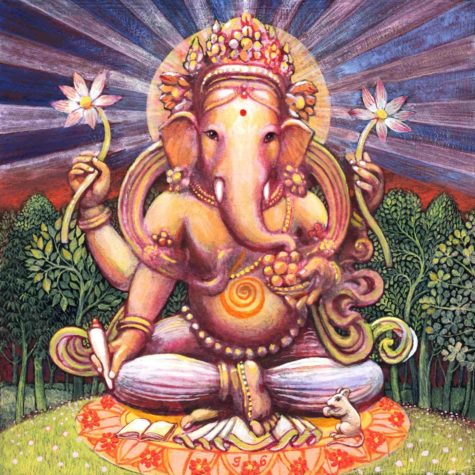
Tradition describes the entire universe as being contained in Lord Ganesha’s big belly. Thus we look upon Him as the overlord who holds sway over the material universe, the sum of cosmic mass. One of His potencies is gravity.
Gravity is a mysterious force to the scientist even today. It is the galactic glue that draws and holds larger mass together and gives order to the macrocosm. It is an instantaneous force, so that when one celestial body moves in a remote corner of a galaxy, all other masses through out the galaxy adjust simultaneously, even though it would take light, at its incredible speed, millions of years to travel the distance.
This implies that space and time are relative concepts and there is “something” that exists everywhere in the universe at once. Like gravity Lord Ganesha is totally predictable and known for orderliness. Without gravity, the known galactic systems could not exist; masses would stray apart; all organization of life as we know it would be impossible. Gravity is the basis of ordered existence in the macrocosm, and our loving Ganesha holds dominion over its mysteries.
Like gravity, Lord Ganesha is always with us, supporting and guiding our physical existence. He is a potent force in the universe, not a representation of potent universal forces. Corpulently built, Lord Ganesha is said to contain within Himself all matter, all mind. He is the very personification of material existence. We look upon this physical world as the body of Lord Ganesha.
In seeing and understanding the varied forces at work in the physical universe, we are seeing and understanding the powers and the being of Lord Ganesha. There is nothing that happens on this material plane of existence except that it is the will of God Shiva and minutely detailed by His beloved son Lord Ganesha. To Him we offer our reverent love and praise.
from Loving Ganesa
by Satguru Sivaya Subramuniyaswami
The Patron of the Ganas
There is a very meaningful story which reveals the way in which this god became the patron of the ganas thus acquiring the title of “Ganesha”.
In the ancient times, Shiva was the single master of all gods, demigods, humans, demons, phantoms, spirits and all other existing beings. But because he was in continuous divine ecstasy (samadhi), it was highly difficult for gods and for the other beings to communicate with him. Whenever they had problems, they had to spend hours singing hymns, praising and praying for Shiva to regain normal state of consciousness. This is why the ganas felt like they needed another leader, who was easier to appeal to. to resolve their problems and protect them in times of need.
They came to Brahma with this issue but he could not resolve it, so he asked for Vishnu’s help in order to convince Shiva to establish a new Ganapati (leader of the ganas). Vishnu suggested they should choose from one of Shiva’s two sons: Kartikeya (also known as Subramaniyam) or Lambodar (Ganesha the fat). In order to find out which of the two deserved the title of Ganesha, all the gods and demi-gods chose to organise a contest.
On the set day, they all came witness the contest, where Vishnu was the judge. Shiva and Parvati were also present, seated in the middle. At the established moment, Vishnu announced the test of the competition. The two competitors had to go around the Universe and the one who would arrive first was to receive the title of Ganesha, master of all ganas.
After the announcement of the test, Kartikeya flew away into space, riding his extremely fast peacock, in order to go around the Universe as quickly as possible. Meanwhile Ganesha remained seated on his rat, without moving from his place. Vishnu, seeing him standing still, told him to hurry.
At Vishnu’s insistence that he should begin the contest immediately, Ganesha smiled and paid homage at the feet of his father and mother, then he humbly saluted all the other gods and demigods, flying away on his rat. They were all astonished when they saw that instead of riding towards cosmic space, Ganesha flew around Shiva and Parvati.
After he rode around Shiva and Shakti, Ganesha returned to the starting point, kneeled before his parents and said: “My task is complete. I have gone round the whole universe.”
“No, you did not!” the gods and demigods exclaimed. “You did not go anywhere. You are lazy”
Ganesha then addressed Vishnu, his hands in a gesture of prayer: “I know you understand the significance of my actions, but in order for the others to understand me as well, I shall say the following. I have completed my task of going round the Universe because all this world of phenomena, names and shapes is nothing other than a manifestation of my Divine Mother and my Divine Father. They are the source of all what exists. I went to the source, which is the Truth, the essence of the whole existence and all phenomena. I know this world is an ocean of relative existence, that it is an illusion that has no sense to renounce the Ultimate Truth in order to go around illusion. My brother is still circling this Universe. When he arrives at the Truth, it will be the same Truth that is Unique and in relation to which all is an illusion, including you and me.”
This statement offered a glimpse of genuine understanding to his listeners who were both astonished and delighted at his wisdom. Applauding his refined judgment and enlightening action, they accepted fat Ganesha as their patron. While Vishnu marked Ganesha’s elephant forehead with the sign of victory (tilak), Kartikeya returned, tired, from his voyage around the world. He got upset and argued against Ganesha’s victory.
The gods then told Kartikeya about his subtlety and wisdom and also said the following: “You went towards matter, which is illusory. You went around the phenomenal world, whose existence is relative and this is why you could not directly perceive the Ultimate Truth. It is the source. The world of phenomena is maya (illusion).” Kartikeya realized he had been fooled by maya and that his rush into the ever changing world of phenomena was in vain. Therefore all his efforts had been pointless for having chased a mirage. Kartikeya had behaved like all the other mortals who take the world of names and shapes for the actual reality, thus being trapped by maya. He accepted his defeat and the one whose wisdom had gone beyond material existence was offered the title of “Ganesha”.
Then Vishnu also decided that from that moment on, all beings should beg for Ganesha’s grace in the beginning of all their actions. Those who invoke him this way shall face no obstacles when accomplishing their beneficent goals and their path will be easy and without difficulties.
Article taken from Yoga Magazine magazine, issue no. 23
